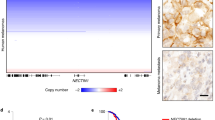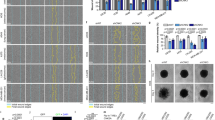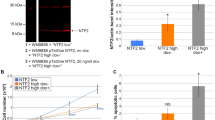Abstract
Tumor cell migration is a well-orchestrated multistep process that drives cancer development and metastasis. Previous data indicated that CD146 expression correlates with malignant progression and metastatic potential of human melanoma cells. However, the exact molecular mechanism of how CD146 promotes melanoma cell migration still remains poorly understood. Here, we report that CD146 physically interacts with actin-linking ezrin–radixin–moesin (ERM) proteins and recruits ERM proteins to cell protrusions, promoting the formation and elongation of microvilli. Moreover, CD146-promoted melanoma cell migration is linked to RhoA activation and ERM phosphorylation. CD146 recruits Rho guanine nucleotide dissociation inhibitory factors 1 (RhoGDI1) through ERM proteins and thus sequesters RhoGDI1 from RhoA, which leads to upregulated RhoA activity and increased melanoma cell motility. CD146-activated RhoA also promotes further ERM phosphorylation and activation through Rho-phosphatidylinositol-4-phosphate-5-kinase-phosphatidylinositol 4,5-biphosphate pathway, which reinforces CD146/ERM association. Thus, our results provide a mechanistic basis to understand the role of CD146 in regulating human melanoma cell motility.
This is a preview of subscription content, access via your institution
Access options
Subscribe to this journal
Receive 50 print issues and online access
$259.00 per year
only $5.18 per issue
Buy this article
- Purchase on Springer Link
- Instant access to full article PDF
Prices may be subject to local taxes which are calculated during checkout








Similar content being viewed by others
Abbreviations
- ERM proteins:
-
ezrin–radixin–moesin proteins
- PIP2:
-
phosphatidylinositol 4,5-biphosphate
- RBD:
-
Rho-binding domain
- RhoGDI1:
-
Rho guanine nucleotide dissociation inhibitory factors 1
- ROCK:
-
Rho-associated coiled-coil protein kinase
References
Aldovini D, Demichelis F, Doglioni C, Di Vizio D, Galligioni E, Brugnara S et al. (2006). M-CAM expression as marker of poor prognosis in epithelial ovarian cancer. Int J Cancer 119: 1920–1926.
Anfosso F, Bardin N, Frances V, Vivier E, Camoin-Jau L, Sampol J et al. (1998). Activation of human endothelial cells via S-endo-1 antigen (CD146) stimulates the tyrosine phosphorylation of focal adhesion kinase p125(FAK). J Biol Chem 273: 26852–26856.
Bani MR, Rak J, Adachi D, Wiltshire R, Trent JM, Kerbel RS et al. (1996). Multiple features of advanced melanoma recapitulated in tumorigenic variants of early stage (radial growth phase) human melanoma cell lines: evidence for a dominant phenotype. Cancer Res 56: 3075–3086.
Barreiro O, Vicente-Manzanares M, Urzainqui A, Yanez-Mo M, Sanchez-Madrid F . (2004). Interactive protrusive structures during leukocyte adhesion and transendothelial migration. Front Biosci 9: 1849–1863.
Barrero-Villar M, Barroso-Gonzalez J, Cabrero JR, Gordon-Alonso M, Alvarez-Losada S, Munoz-Fernandez MA et al. (2008) PI4P5-kinase Ialpha is required for efficient HIV-1 entry and infection of T cells. J Immunol 181: 6882–6888.
Bartolome RA, Wright N, Molina-Ortiz I, Sanchez-Luque FJ, Teixido J . (2008). Activated G(alpha)13 impairs cell invasiveness through p190RhoGAP-mediated inhibition of RhoA activity. Cancer Res 68: 8221–8230.
Bidlingmaier S, He J, Wang Y, An F, Feng J, Barbone D et al. (2009). Identification of MCAM/CD146 as the target antigen of a human monoclonal antibody that recognizes both epithelioid and sarcomatoid types of mesothelioma. Cancer Res 69: 1570–1577.
Boureux A, Vignal E, Faure S, Fort P . (2007). Evolution of the Rho family of ras-like GTPases in eukaryotes. Mol Biol Evol 24: 203–216.
Bretscher A, Chambers D, Nguyen R, Reczek D . (2000). ERM-Merlin and EBP50 protein families in plasma membrane organization and function. Annu Rev Cell Dev Biol 16: 113–143.
Bretscher A, Edwards K, Fehon RG . (2002). ERM proteins and merlin: integrators at the cell cortex. Nat Rev 3: 586–599.
Bretscher A, Reczek D, Berryman M . (1997). Ezrin: a protein requiring conformational activation to link microfilaments to the plasma membrane in the assembly of cell surface structures. J Cell Sci 110 (Part 24): 3011–3018.
Bu P, Gao L, Zhuang J, Feng J, Yang D, Yan X . (2006). Anti-CD146 monoclonal antibody AA98 inhibits angiogenesis via suppression of nuclear factor-kappaB activation. Mol Cancer Therap 5: 2872–2878.
Crepaldi T, Gautreau A, Comoglio PM, Louvard D, Arpin M . (1997). Ezrin is an effector of hepatocyte growth factor-mediated migration and morphogenesis in epithelial cells. J Cell Biol 138: 423–434.
DerMardirossian C, Bokoch GM . (2005). GDIs: central regulatory molecules in Rho GTPase activation. Trends Cell Biol 15: 356–363.
Dovas A, Couchman JR . (2005). RhoGDI: multiple functions in the regulation of Rho family GTPase activities. Biochem J 390: 1–9.
Gadea G, de Toledo M, Anguille C, Roux P . (2007). Loss of p53 promotes RhoA-ROCK-dependent cell migration and invasion in 3D matrices. J Cell Biol 178: 23–30.
Gervais L, Claret S, Januschke J, Roth S, Guichet A . (2008). PIP5K-dependent production of PIP2 sustains microtubule organization to establish polarized transport in the Drosophila oocyte. Development (Cambridge, England) 135: 3829–3838.
Guezguez B, Vigneron P, Alais S, Jaffredo T, Gavard J, Mege RM et al. (2006). A dileucine motif targets MCAM-l cell adhesion molecule to the basolateral membrane in MDCK cells. FEBS Lett 580: 3649–3656.
Hebert M, Potin S, Sebbagh M, Bertoglio J, Breard J, Hamelin J . (2008). Rho-ROCK-dependent ezrin–radixin–moesin phosphorylation regulates Fas-mediated apoptosis in Jurkat cells. J Immunol 181: 5963–5973.
Hirao M, Sato N, Kondo T, Yonemura S, Monden M, Sasaki T et al. (1996). Regulation mechanism of ERM (ezrin/radixin/moesin) protein/plasma membrane association: possible involvement of phosphatidylinositol turnover and Rho-dependent signaling pathway. J Cell Biol 135: 37–51.
Johnson JP, Bar-Eli M, Jansen B, Markhof E . (1997). Melanoma progression-associated glycoprotein MUC18/MCAM mediates homotypic cell adhesion through interaction with a heterophilic ligand. Int J Cancer 73: 769–774.
Johnson JP, Rothbacher U, Sers C . (1993). The progression associated antigen MUC18: a unique member of the immunoglobulin supergene family. Melanoma Res 3: 337–340.
Kristiansen G, Yu Y, Schluns K, Sers C, Dietel M, Petersen I . (2003). Expression of the cell adhesion molecule CD146/MCAM in non-small cell lung cancer. Anal Cell Pathol 25: 77–81.
Lacalle RA, Peregil RM, Albar JP, Merino E, Martinez AC, Merida I et al. (2007) Type I phosphatidylinositol 4-phosphate 5-kinase controls neutrophil polarity and directional movement. J Cell Biol 179: 1539–1553.
Lee JH, Katakai T, Hara T, Gonda H, Sugai M, Shimizu A . (2004). Roles of p-ERM and Rho-ROCK signaling in lymphocyte polarity and uropod formation. J Cell Biol 167: 327–337.
Li G, Satyamoorthy K, Herlyn M . (2002). Dynamics of cell interactions and communications during melanoma development. Crit Rev Oral Biol Med 13: 62–70.
Louvet-Vallee S . (2000). ERM proteins: from cellular architecture to cell signaling. Biol Cell/Under Ausp Eur Cell Biol Org 92: 305–316.
Luca M, Hunt B, Bucana CD, Johnson JP, Fidler IJ, Bar-Eli M . (1993). Direct correlation between MUC18 expression and metastatic potential of human melanoma cells. Melanoma Res 3: 35–41.
Luna EJ, Hitt AL . (1992). Cytoskeleton—plasma membrane interactions. Science (New York, NY) 258: 955–964.
Mangeat P, Roy C, Martin M . (1999). ERM proteins in cell adhesion and membrane dynamics. Trends Cell Biol 9: 187–192.
Masiero L, Lapidos KA, Ambudkar I, Kohn EC . (1999). Regulation of the RhoA pathway in human endothelial cell spreading on type IV collagen: role of calcium influx. J Cell Sci 112 (Part 19): 3205–3213.
Matsui T, Yonemura S, Tsukita S, Tsukita S . (1999). Activation of ERM proteins in vivo by Rho involves phosphatidylinositol 4-phosphate 5-kinase and not ROCK kinases. Curr Biol 9: 1259–1262.
McClatchey AI . (2003). Merlin and ERM proteins: unappreciated roles in cancer development? Nat Rev Cancer 3: 877–883.
McClatchey AI, Fehon RG . (2009). Merlin and the ERM proteins—regulators of receptor distribution and signaling at the cell cortex. Trends Cell Biol 19: 198–206.
Molina-Ortiz I, Bartolome RA, Hernandez-Varas P, Colo GP, Teixido J . (2009). Overexpression of E-cadherin on melanoma cells inhibits chemokine-promoted invasion involving p190RhoGAP/p120ctn-dependent inactivation of RhoA. J Biol Chem 284: 15147–15157.
Niggli V, Rossy J . (2008). Ezrin/radixin/moesin: versatile controllers of signaling molecules and of the cortical cytoskeleton. Int J Biochem Cell Biol 40: 344–349.
Oleksy A, Opalinski L, Derewenda U, Derewenda ZS, Otlewski J . (2006). The molecular basis of RhoA specificity in the guanine nucleotide exchange factor PDZ-RhoGEF. J Biol Chem 281: 32891–32897.
Olofsson B . (1999). Rho guanine dissociation inhibitors: pivotal molecules in cellular signalling. Cell Signal 11: 545–554.
Ouhtit A, Gaur RL, Abd Elmageed ZY, Fernando A, Thouta R, Trappey AK et al. (2009). Towards understanding the mode of action of the multifaceted cell adhesion receptor CD146. Biochim Biophys Acta 1795: 130–136.
Raucher D, Stauffer T, Chen W, Shen K, Guo S, York JD et al. (2000). Phosphatidylinositol 4,5-bisphosphate functions as a second messenger that regulates cytoskeleton–plasma membrane adhesion. Cell 100: 221–228.
Ridley AJ . (2006). Rho GTPases and actin dynamics in membrane protrusions and vesicle trafficking. Trends Cell Biol 16: 522–529.
Saci A, Carpenter C . (2005). RhoA GTPase regulates B cell receptor signaling. Mol Cell 17: 205–214.
Shibasaki Y, Ishihara H, Kizuki N, Asano T, Oka Y, Yazaki Y . (1997). Massive actin polymerization induced by phosphatidylinositol-4-phosphate 5-kinase in vivo. J Cell Biol 272: 7578–7581.
Shih IM, Elder DE, Speicher D, Johnson JP, Herlyn M . (1994). Isolation and functional characterization of the A32 melanoma-associated antigen. Cancer Res 54: 2514–2520.
Shih IM, Speicher D, Hsu MY, Levine E, Herlyn M . (1997). Melanoma cell–cell interactions are mediated through heterophilic Mel-CAM/ligand adhesion. Cancer Res 57: 3835–3840.
Takahashi K, Sasaki T, Mammoto A, Takaishi K, Kameyama T, Tsukita S et al. (1997). Direct interaction of the Rho GDP dissociation inhibitor with ezrin/radixin/moesin initiates the activation of the Rho small G protein. J Biol Chem 272: 23371–23375.
Tsukita S, Yonemura S . (1999). Cortical actin organization: lessons from ERM (ezrin/radixin/moesin) proteins. J Biol Chem 274: 34507–34510.
Witze ES, Litman ES, Argast GM, Moon RT, Ahn NG . (2008). Wnt5a control of cell polarity and directional movement by polarized redistribution of adhesion receptors. Science (New York, NY) 320: 365–369.
Worthylake RA, Burridge K . (2003). RhoA and ROCK promote migration by limiting membrane protrusions. J Biol Chem 278: 13578–13584.
Wu GJ, Peng Q, Fu P, Wang SW, Chiang CF, Dillehay DL et al. (2004). Ectopical expression of human MUC18 increases metastasis of human prostate cancer cells. Gene 327: 201–213.
Wu GJ, Wu MW, Wang SW, Liu Z, Qu P, Peng Q et al. (2001). Isolation and characterization of the major form of human MUC18 cDNA gene and correlation of MUC18 over-expression in prostate cancer cell lines and tissues with malignant progression. Gene 279: 17–31.
Xie S, Luca M, Huang S, Gutman M, Reich R, Johnson JP et al. (1997). Expression of MCAM/MUC18 by human melanoma cells leads to increased tumor growth and metastasis. Cancer Res 57: 2295–2303.
Yan X, Lin Y, Yang D, Shen Y, Yuan M, Zhang Z et al. (2003). A novel anti-CD146 monoclonal antibody, AA98, inhibits angiogenesis and tumor growth. Blood 102: 184–191.
Yang NY, Pasquale EB, Owen LB, Ethell IM . (2006). The EphB4 receptor-tyrosine kinase promotes the migration of melanoma cells through Rho-mediated actin cytoskeleton reorganization. J Biol Chem 281: 32574–32586.
Zheng C, Qiu Y, Zeng Q, Zhang Y, Lu D, Yang D et al. (2009). Endothelial CD146 is required for in vitro tumor-induced angiogenesis: the role of a disulfide bond in signaling and dimerization. Int J Biochem Cell Biol 41: 2163–2172.
Acknowledgements
We thank Dr J Johnson for providing the CD146-transfected Mel-888CD146 cells and CD146 gene contained in pUC-CD146 plasmids. This work is partly supported by grants from the National 863 Grant (2006AA02A245), the National Basic Research Program of China (973 Program) (2009CB521704, 2011CB933503), the National Important Science and Technology Specific Projects (2008ZX10004-005, 2008ZX10002-017, 2009ZX09102-247), the National Natural Science Foundation of China (91029732) and the Knowledge Innovation Program of the Chinese Academy of Sciences (KSCX2-YW-R-121, KSCX2-YW-R-173, KSCX2-YW-M15).
Author contributions: YL and CZ designed, carried out experiments, analyzed data and wrote the paper. JZ performed experiments and carried out image analyses. DL, JZ and SX contributed to experimental design, data analysis and expertise. JF and DY contributed to experimental design and data analysis. XY designed the project, designed experiments and analyzed data.
Author information
Authors and Affiliations
Corresponding author
Ethics declarations
Competing interests
The authors declare no conflict of interest.
Additional information
Supplementary Information accompanies the paper on the Oncogene website
Supplementary information
Rights and permissions
About this article
Cite this article
Luo, Y., Zheng, C., Zhang, J. et al. Recognition of CD146 as an ERM-binding protein offers novel mechanisms for melanoma cell migration. Oncogene 31, 306–321 (2012). https://doi.org/10.1038/onc.2011.244
Received:
Revised:
Accepted:
Published:
Issue Date:
DOI: https://doi.org/10.1038/onc.2011.244
Keywords
This article is cited by
-
The CD146-HIF-1α axis regulates epithelial cell migration and alveolar maturation in a mouse model of bronchopulmonary dysplasia
Laboratory Investigation (2022)
-
Moesin as a prognostic indicator of lung adenocarcinoma improves prognosis by enhancing immune lymphocyte infiltration
World Journal of Surgical Oncology (2021)
-
CD146, from a melanoma cell adhesion molecule to a signaling receptor
Signal Transduction and Targeted Therapy (2020)
-
CD146-HIF-1α hypoxic reprogramming drives vascular remodeling and pulmonary arterial hypertension
Nature Communications (2019)
-
CD146 is essential for PDGFRβ-induced pericyte recruitment
Protein & Cell (2018)



